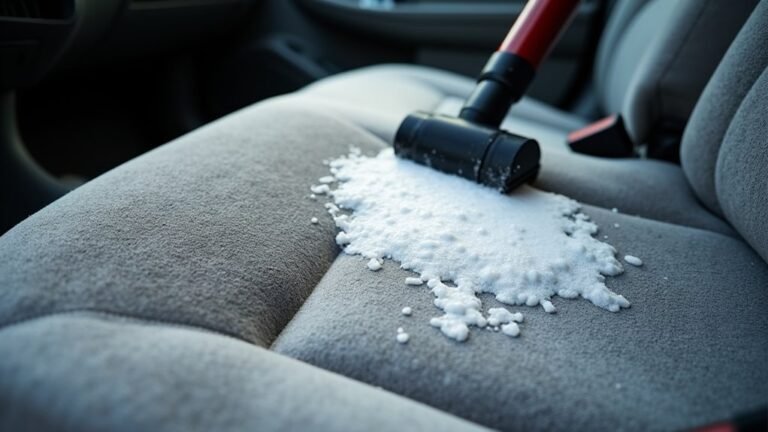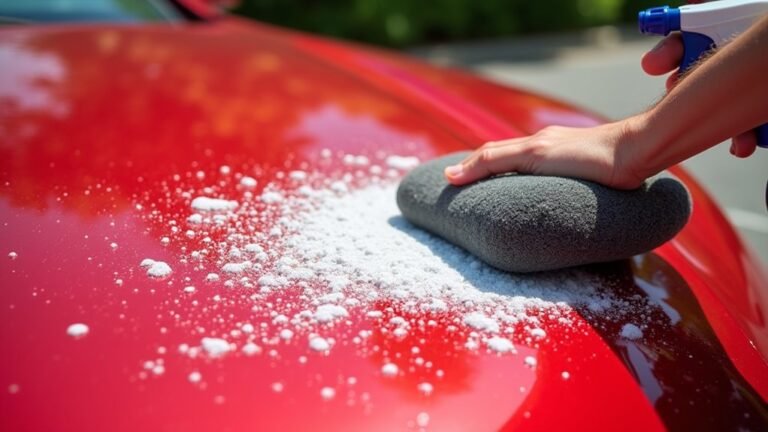A dirty oven isn’t just an eyesore – it can affect how well your food cooks and fill your kitchen with smoke and bad smells. According to Sarah Brown, cleaning expert at The Spruce, “A clean oven can improve your food’s taste and help your appliance work better, while cutting down on smoke and burning smells that can spread through your home.” The good news is that you don’t have to put up with a messy oven. With the right cleaning methods, you can turn your greasy oven into a clean cooking space that you’ll be proud to use.
Oven Upkeep Made Simple

While keeping your oven clean might seem like a challenging task, it’s actually quite manageable with regular maintenance.
Let’s focus on wiping down oven surfaces after each use to prevent grease and grime buildup.
Regular wipes after using your oven prevent stubborn grease from building up, making deep cleaning much easier down the road.
We recommend you deep clean your oven every three months using a baking soda paste, which works wonders on stubborn spots. Regular cleaning helps maintain oven safety and efficiency and ensures you get the most out of your appliance.
Don’t forget to soak those oven racks separately to tackle unpleasant odors and burnt-on food.
Let’s explore the essential aspects of oven cleaning, including what works best and what to avoid for ideal results.
We’ll cover the step-by-step process that makes cleaning your oven easier, from using natural cleaners to maintaining a regular schedule.
Whether you’re dealing with baked-on spills or general maintenance, we’ll help you understand the most effective cleaning methods while protecting your appliance’s longevity.
Things to Do When Cleaning An Oven
Before tackling the task of cleaning your oven, it’s important to understand that proper preparation and timing are vital for achieving ideal results. A thorough oven cleaning requires careful attention to detail and following specific steps in the correct order, ensuring that both the interior surfaces and removable components receive appropriate treatment for maximum cleanliness.
- Remove all racks and items – Clear the entire oven cavity to access all surfaces freely.
- Mix cleaning paste – Combine baking soda and water to create a spreadable consistency.
- Apply paste thoroughly – Cover all dirty surfaces except heating elements.
- Allow sufficient dwell time – Let paste sit for 12-24 hours to break down grease.
- Prepare vinegar solution – Fill spray bottle with white vinegar for residue removal.
- Soak racks separately – Immerse in hot, soapy water while paste works.
- Wipe clean – Remove paste and spray vinegar on remaining residue.
- Scrub racks – Clean soaked racks with scrubbing pad or brush.
- Final inspection – Check all surfaces and reapply paste if needed.
- Reassemble – Return clean racks to dried oven interior.
Things to Avoid When Cleaning An Oven
When cleaning an oven, it’s essential to be aware of potentially damaging cleaning methods that could harm both the appliance and its functionality.
Using improper techniques or harsh materials can lead to permanent damage, reduced performance, and even safety hazards that could affect the oven’s operation or create dangerous situations in your kitchen.
- Abrasive cleaning powders and scour pads – These can create scratches on stainless steel surfaces and damage protective finishes.
- Excessive water or cleaning solutions – Can seep into internal components and cause electrical issues or corrosion.
- Vacuum cleaners – Risk of spreading grease and creating fire hazards when cleaning debris.
- Extended exposure to cleaning products – Chemical cleaners left too long can cause discoloration and surface damage.
- Incorrect self-cleaning cycles – Not following manufacturer guidelines can lead to overheating and component damage.
- Steel wool or metal scrapers – Can leave permanent scratches and remove protective coatings.
- Bleach-based cleaners – May react with other cleaning products and create harmful fumes.
- Commercial oven cleaners on self-cleaning ovens – Can damage the special coating designed for the self-cleaning feature.
Steps
Cleaning an oven effectively requires careful preparation and patience to achieve ideal results. The process involves removing all items from the oven, creating a natural cleaning solution with baking soda, allowing sufficient time for the cleaning agents to work, and thoroughly removing residue before completing the final steps.
Step 1: Remove all racks and items from the oven interior
Step 2: Mix 1/2 cup baking soda with water to create a spreadable paste
Step 3: Apply the baking soda paste evenly throughout the oven’s interior surfaces
Step 4: Let the paste sit for 12 hours or overnight
Step 5: Fill sink with hot, soapy water and soak oven racks
Step 6: Wipe out the oven interior with a damp cloth
Step 7: Use a spatula to remove stubborn spots
Step 8: Spray vinegar on any remaining baking soda residue
Step 9: Clean oven racks with scrubbing brush and rinse thoroughly
Step 10: Dry racks completely and return them to the clean oven
Final Thoughts
A well-maintained oven isn’t just about following a checklist of cleaning steps – it’s about creating a safer, more efficient cooking environment in your kitchen.
Whether you choose natural solutions like baking soda and vinegar or utilize your oven’s self-cleaning feature, regular maintenance every three months will prevent grease buildup and food residue.

Natural oven cleaning isn’t only safer for your health but also highly effective when done properly. The simple combination of baking soda and water, followed by vinegar when needed, can tackle even the toughest oven grime without exposing your kitchen to harsh chemicals. Regular maintenance is key – implementing a schedule of deep cleaning every three months while keeping up with quick post-cooking wipe-downs will prevent major buildup and keep your oven in ideal condition. Additionally, immediate spill cleanup can significantly minimize the need for deep cleaning sessions.
Don’t let a dirty oven impact your cooking or kitchen hygiene any longer. Set aside time this weekend to give your oven the thorough cleaning it deserves. With these natural cleaning methods and a consistent maintenance routine, you can enjoy a cleaner, more efficient oven that produces better-tasting food and creates a healthier cooking environment for you and your family.






